Studies show that employees with plants in their workspace are 15% more productive than those without any greenery. You’ll discover that transforming your office environment doesn’t require a complete renovation; strategic placement of the right plants can significantly impact both air quality and aesthetics. From low-light varieties that thrive in windowless spaces to compact succulents perfect for your desk, these eight plant selections will help you create a more vibrant, healthier workplace.
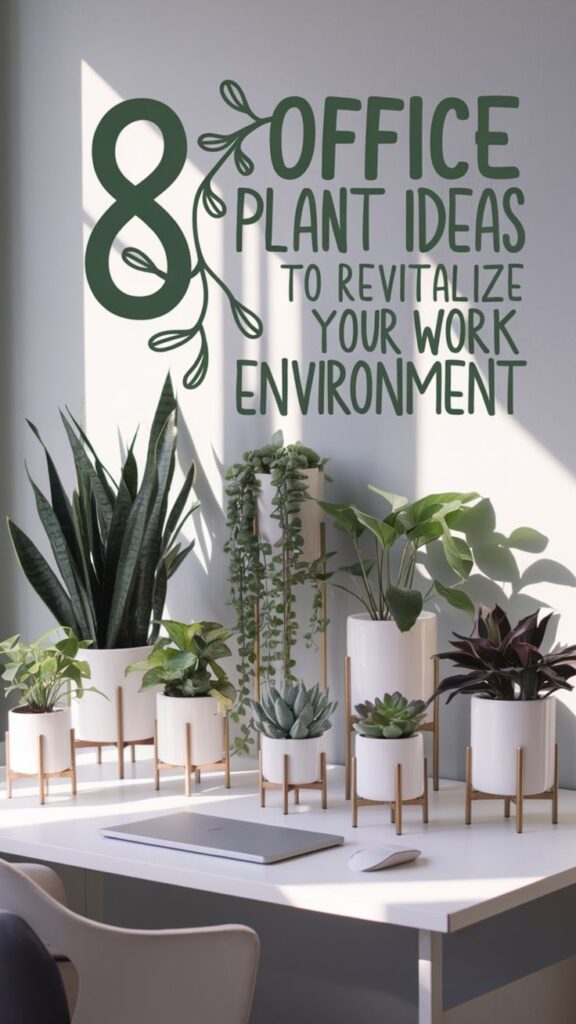
Contents
- 1 Low-Light Champions: The Best Plants for Windowless Offices
- 2 Desktop-Friendly Succulents and Cacti
- 3 Air-Purifying Powerhouses for Your Workspace
- 4 Hanging Plants to Maximize Office Space
- 5 Statement Plants for Meeting Rooms and Reception Areas
- 6 Stress-Reducing Plants With Aromatherapy Benefits
- 7 Easy-Care Office Plants for Busy Professionals
- 8 Colorful Flowering Plants to Brighten Your Workspace
Low-Light Champions: The Best Plants for Windowless Offices
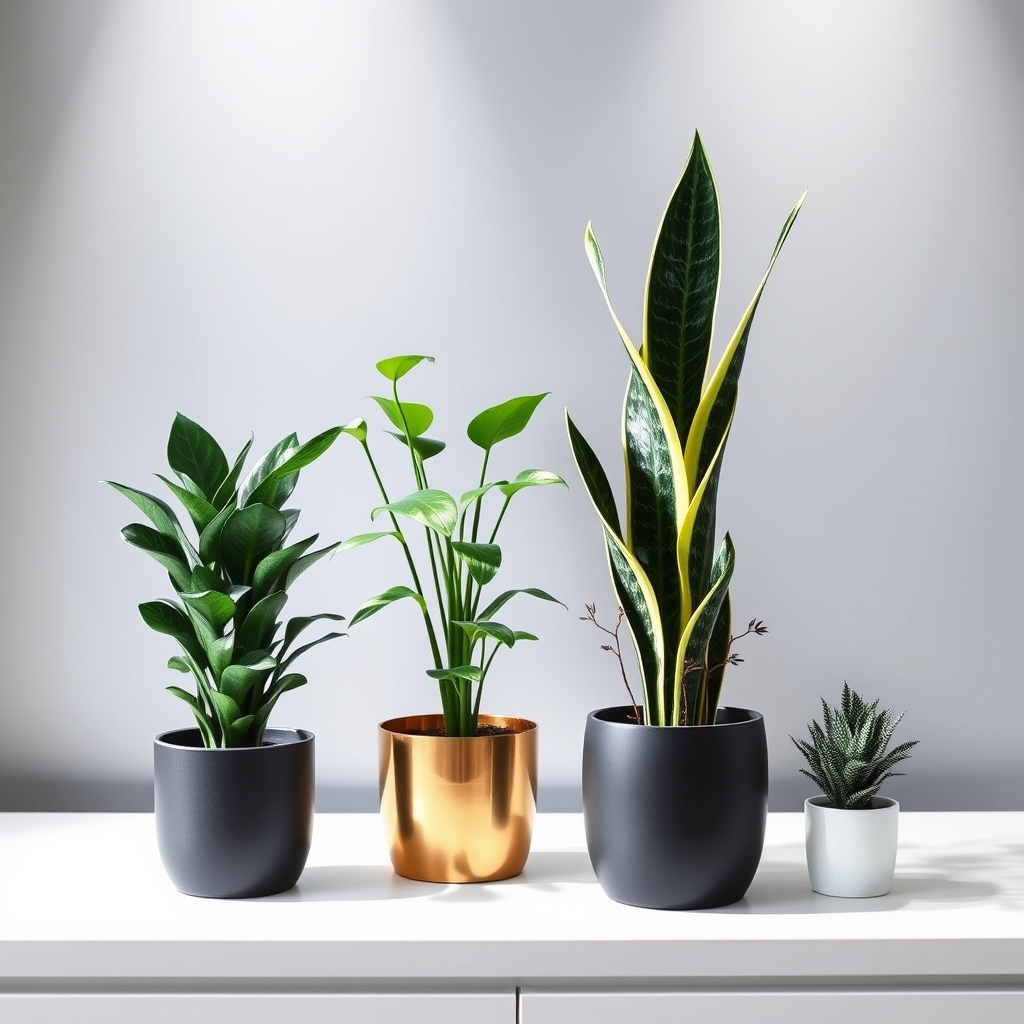
Snake Plant (Sansevieria)
- Tall, upright leaves with sharp points and variegated patterns
- Tolerates extreme low-light conditions
- Purifies air by removing toxins like formaldehyde
- Grows 6 inches to 8 feet tall depending on variety
Growing Conditions:
- Minimal light requirements; thrives in fluorescent lighting
- Water only when soil is completely dry (every 2-8 weeks)
- Well-draining potting mix
- Tolerates temperatures between 60-85°F
ZZ Plant (Zamioculcas zamiifolia)
- Glossy, dark green leaves on arching stems
- Extremely drought-tolerant
- Grows slowly but steadily in low light
- Reaches 2-3 feet in height
Growing Conditions:
- Survives in almost zero natural light
- Water every 2-3 weeks
- Standard potting soil with good drainage
- Average room temperatures (65-75°F)
Chinese Evergreen (Aglaonema)
- Broad, decorative leaves with silver or cream patterns
- Compact growth habit
- Air-purifying qualities
- Various cultivars available
Growing Conditions:
- Thrives in low to moderate light
- Keep soil consistently moist but not wet
- Rich, well-draining potting mix
- Prefers warm temperatures (65-80°F)
Maintenance Tips:
- Dust leaves monthly with damp cloth
- Rotate plants quarterly for even growth
- Check for pests regularly
- Remove dead or yellowing leaves
- Fertilize lightly during growing season
- Monitor soil moisture with finger test
- Maintain stable room temperature
- Clean plant containers annually
Desktop-Friendly Succulents and Cacti
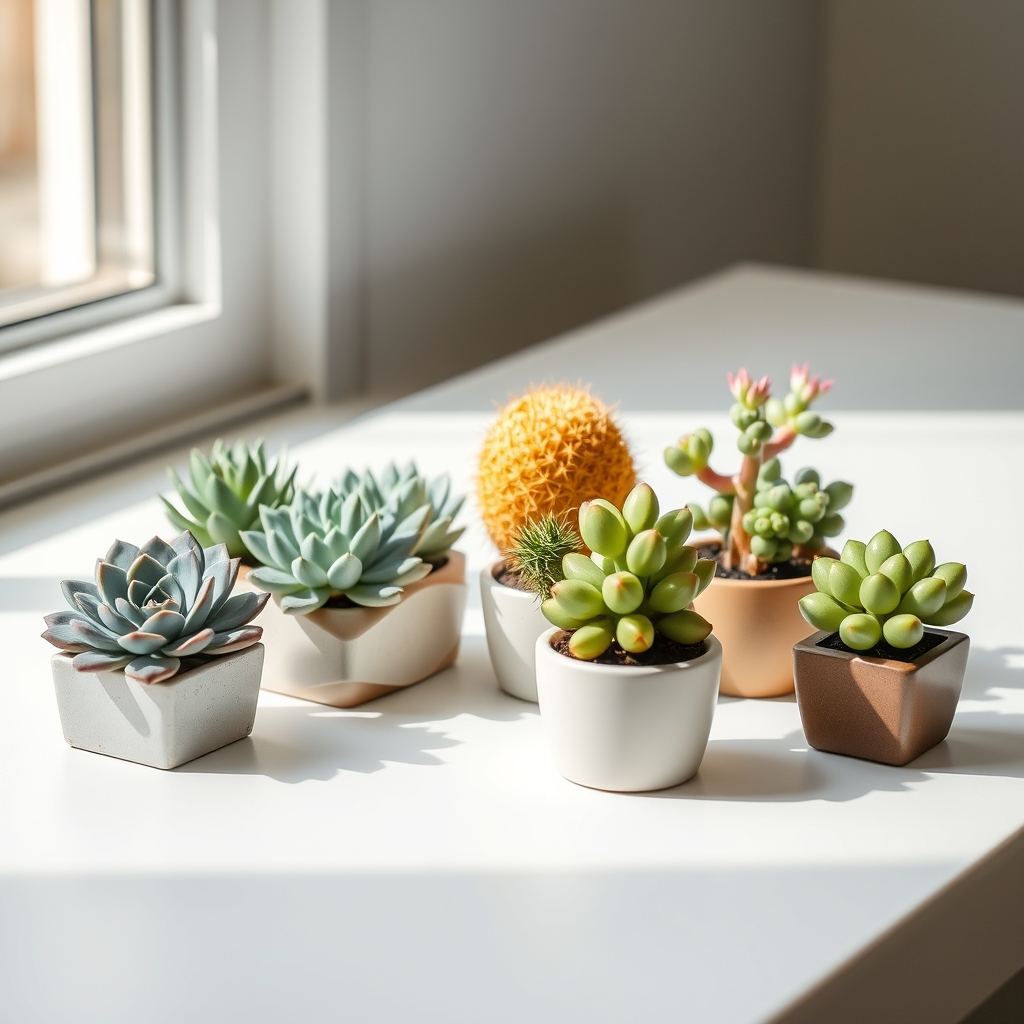
Appearance and Features:
Desktop-friendly succulents and cacti are compact plants characterized by thick, fleshy leaves or stems that store water. They come in various shapes, sizes, and colors, from rosette-formed echeverias to round barrel cacti.
These plants typically remain small, making them perfect for desk spaces, and many feature unique textures, patterns, and architectural forms.
Growing Conditions:
- Light: Bright, indirect sunlight; place near windows with southern or western exposure
- Water: Minimal watering; allow soil to dry completely between waterings
- Soil: Well-draining cactus or succulent mix
- Temperature: 65-80°F (18-27°C)
- Humidity: Low to moderate; tolerant of dry office conditions
- Container: Small pots with drainage holes
Maintenance Tips:
- Water only when the soil is completely dry (typically every 1-2 weeks)
- Rotate plants quarterly for even growth
- Remove dust from leaves with a soft brush
- Prune dead leaves or stems as needed
- Repot every 2-3 years or when outgrowing current container
- Watch for signs of overwatering, such as yellowing leaves or stem rot
- Fertilize sparingly during growing season (spring and summer) with cactus fertilizer
Air-Purifying Powerhouses for Your Workspace
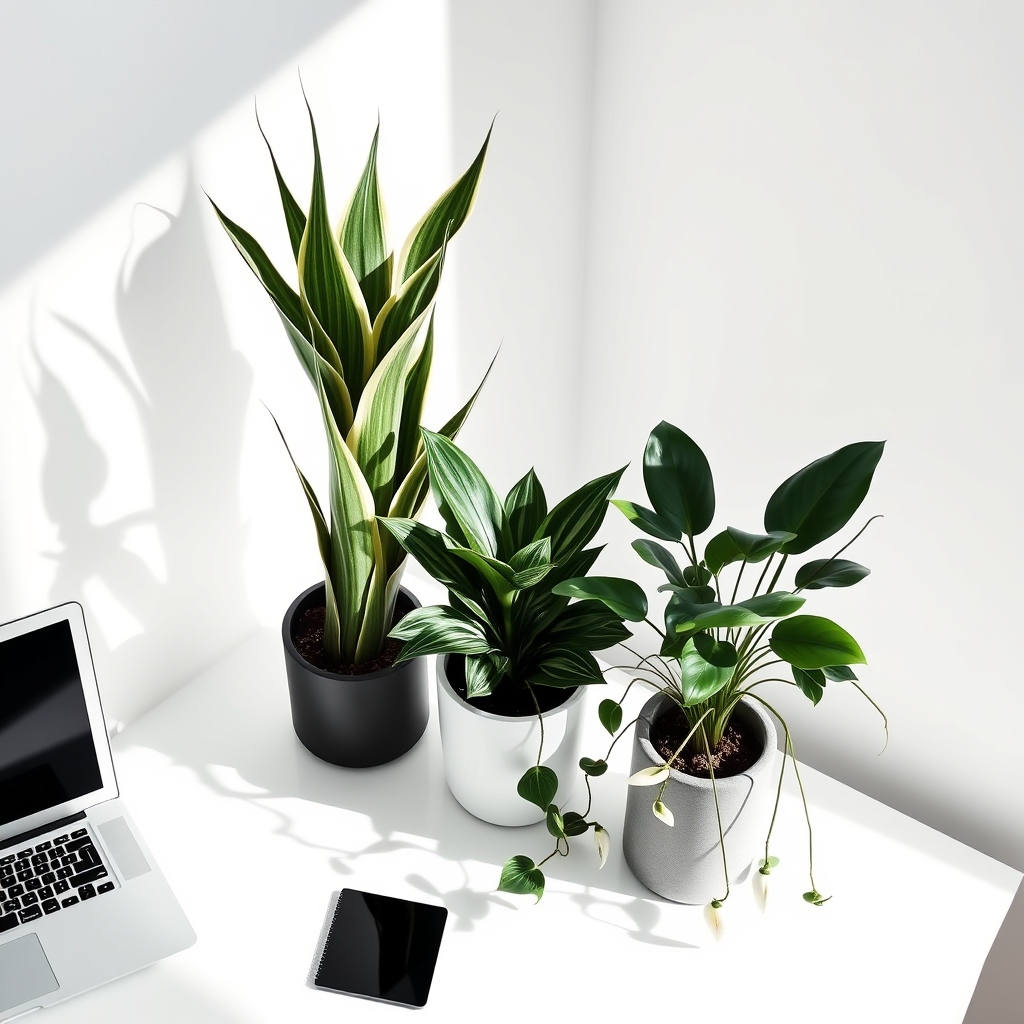
Snake Plant (Sansevieria)
- Tall, upright leaves with sharp edges and variegated patterns
- Naturally filters formaldehyde, benzene, and trichloroethylene
- Converts CO2 to oxygen at night, improving air quality
Spider Plant (Chlorophytum comosum)
- Arching green and white striped leaves with hanging plantlets
- Removes xylene, formaldehyde, and carbon monoxide
- Dense foliage provides excellent air filtration
Peace Lily (Spathiphyllum)
- Glossy dark leaves with white flower spathes
- Eliminates common indoor pollutants and mold spores
- NASA-recognized for superior air-purifying abilities
Growing Conditions:
- Light: Low to moderate indirect light
- Water: Snake Plant and Spider Plant – allow soil to dry between waterings
Peace Lily – keep soil consistently moist
- Temperature: 65-80°F (18-27°C)
- Humidity: Average room humidity (40-50%)
- Soil: Well-draining potting mix
Maintenance Tips:
- Dust leaves monthly with damp cloth for optimal air filtration
- Rotate plants quarterly for even growth
- Trim yellowed or dead foliage promptly
- Repot every 2-3 years or when roots become crowded
- Monitor for common pests like spider mites and mealybugs
- Fertilize lightly during growing season (spring/summer)
Hanging Plants to Maximize Office Space
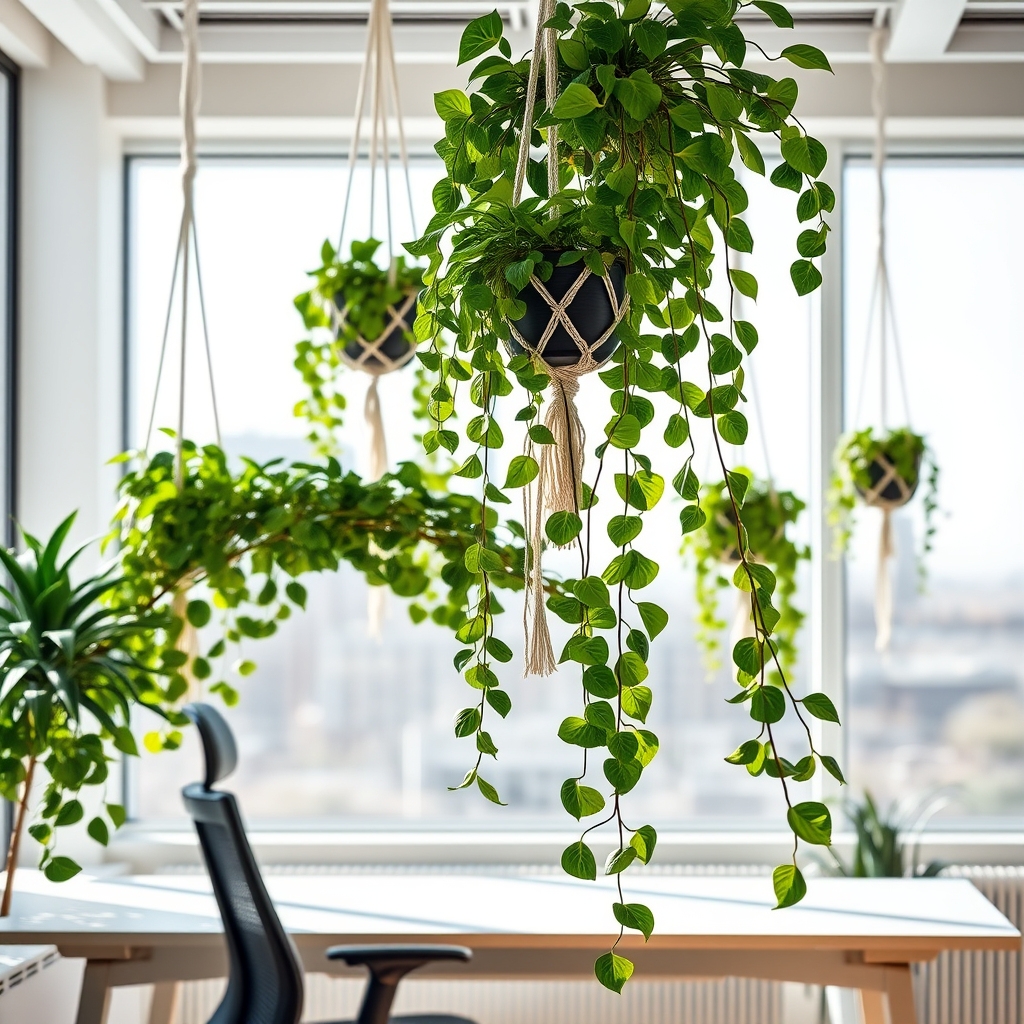
Hanging plants create vertical interest while preserving valuable desk and floor space in office environments. These plants cascade downward from suspended pots, baskets, or wall-mounted planters, adding natural beauty without cluttering workspace surfaces.
Popular office hanging plants include:
- Pothos (heart-shaped leaves, trailing vines)
- Spider plants (arching green and white striped leaves)
- String of pearls (small bead-like leaves on delicate stems)
- English ivy (classic climbing vine with pointed leaves)
Ideal Growing Conditions:
- Light: Medium to bright indirect light; avoid direct sunlight
- Water: Allow top inch of soil to dry between waterings
- Temperature: 65-80°F (18-27°C)
- Humidity: 40-50% relative humidity
- Soil: Well-draining potting mix with good aeration
Maintenance Tips:
- Rotate plants quarterly for even growth
- Dust leaves monthly with damp cloth
- Trim yellowing or dead foliage promptly
- Check hanging hardware regularly for security
- Fertilize monthly during growing season with balanced liquid fertilizer
- Repot every 2-3 years or when roots become crowded
- Monitor for pests, especially spider mites and mealybugs
Statement Plants for Meeting Rooms and Reception Areas
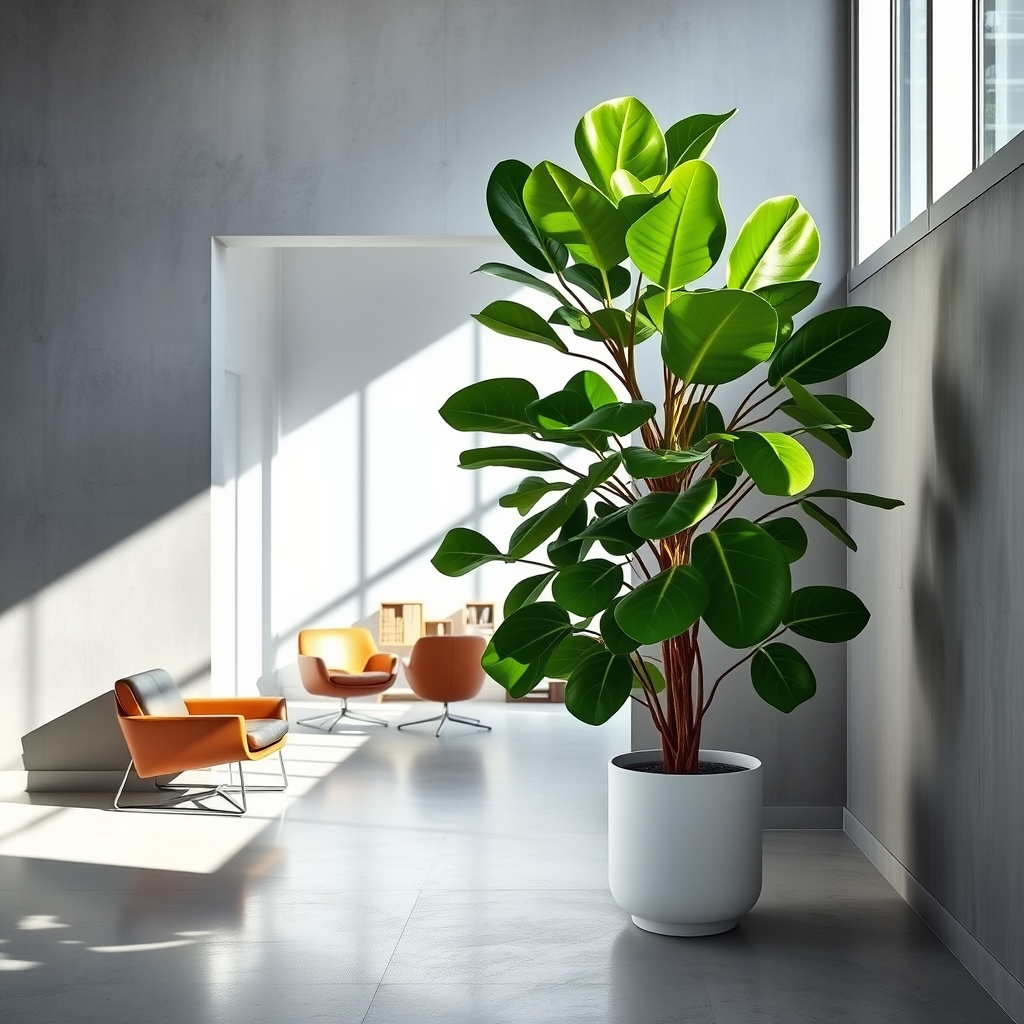
Description:
Statement plants are large, visually striking specimens that create focal points and make powerful first impressions in professional spaces. Common examples include:
- Fiddle Leaf Fig (Ficus lyrata) – tall with dramatic, violin-shaped leaves
- Bird of Paradise (Strelitzia reginae) – broad, tropical foliage with exotic flowers
- Dragon Tree (Dracaena marginata) – architectural form with sword-like leaves
- Monstera deliciosa – large, glossy leaves with distinctive splits
- Kentia Palm (Howea forsteriana) – elegant fronds and commanding height
Ideal Growing Conditions:
Light: Bright, indirect light; avoid direct sunlight which can scorch leaves
Temperature: 65-80°F (18-27°C)
Humidity: 40-60%
Soil: Well-draining potting mix with good aeration
Container: Large, sturdy pots with drainage holes
Space: Minimum 3-foot clearance around plant for proper air circulation
Maintenance Tips:
- Rotate plants quarterly for even growth
- Dust leaves monthly with damp cloth
- Prune dead or yellowing leaves promptly
- Check soil moisture weekly; water when top 2 inches feel dry
- Fertilize with balanced, water-soluble fertilizer every 2-3 months during growing season
- Inspect regularly for pests, especially under leaves
- Repot every 2-3 years or when roots become visible at drainage holes
Stress-Reducing Plants With Aromatherapy Benefits
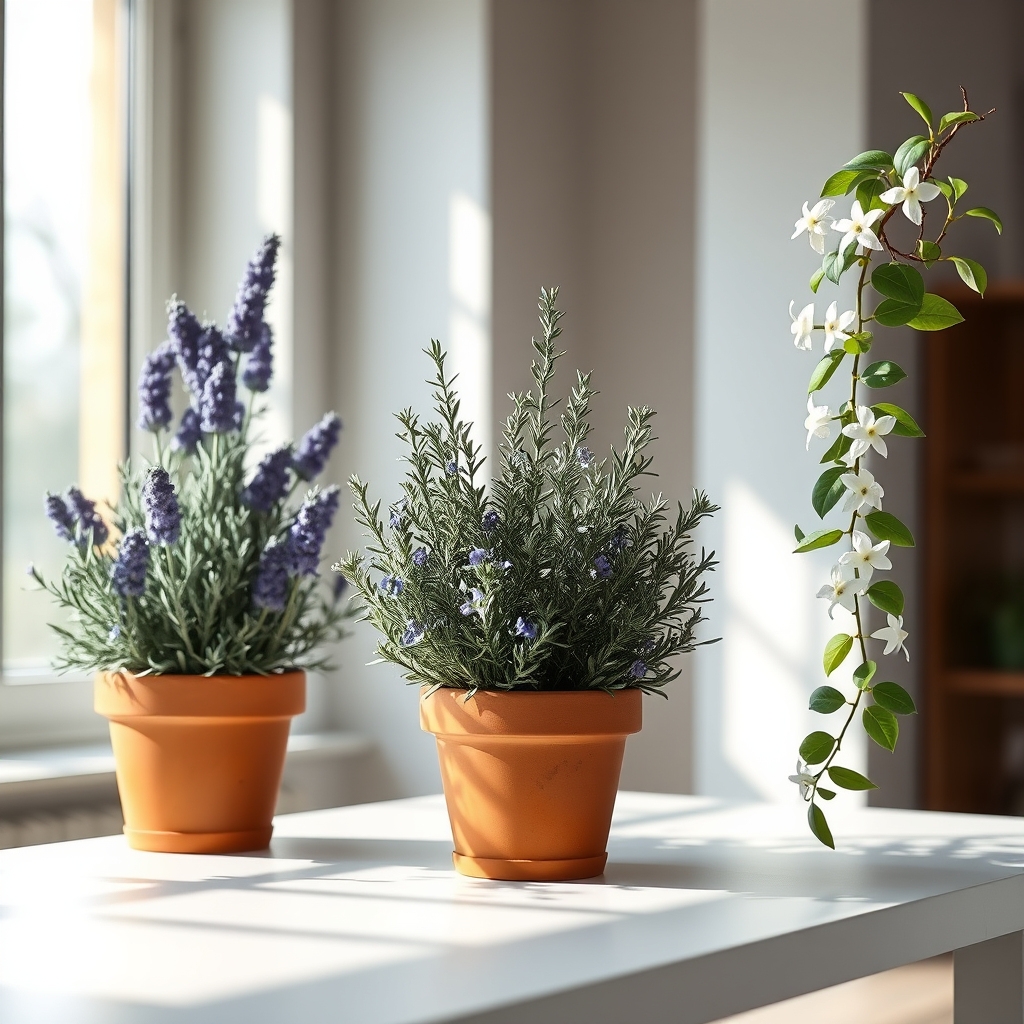
Description:
Aromatherapy plants release natural fragrances that help reduce stress and create a calming office environment. Popular options include lavender (purple spiky blooms, silvery-green foliage), rosemary (needle-like leaves, blue flowers), and jasmine (delicate white flowers, glossy leaves).
These plants not only provide visual appeal but also release soothing scents when their leaves are gently touched or when flowering.
Growing Conditions:
- Light: Bright, indirect sunlight; minimum 6 hours daily
- Water: Moderate watering; soil should be kept slightly moist
- Temperature: 65-75°F (18-24°C)
- Humidity: 40-60%
- Soil: Well-draining potting mix with good aeration
- Container: Pots with drainage holes; terra cotta works well
Maintenance Tips:
- Trim regularly to maintain shape and promote bushier growth
- Remove dead leaves and spent flowers promptly
- Rotate pot quarterly for even growth
- Fertilize monthly during growing season with balanced fertilizer
- Mist leaves weekly to increase humidity
- Prune when plants become leggy
- Check for pests regularly, especially spider mites and aphids
- Repot annually or when roots become crowded
Easy-Care Office Plants for Busy Professionals
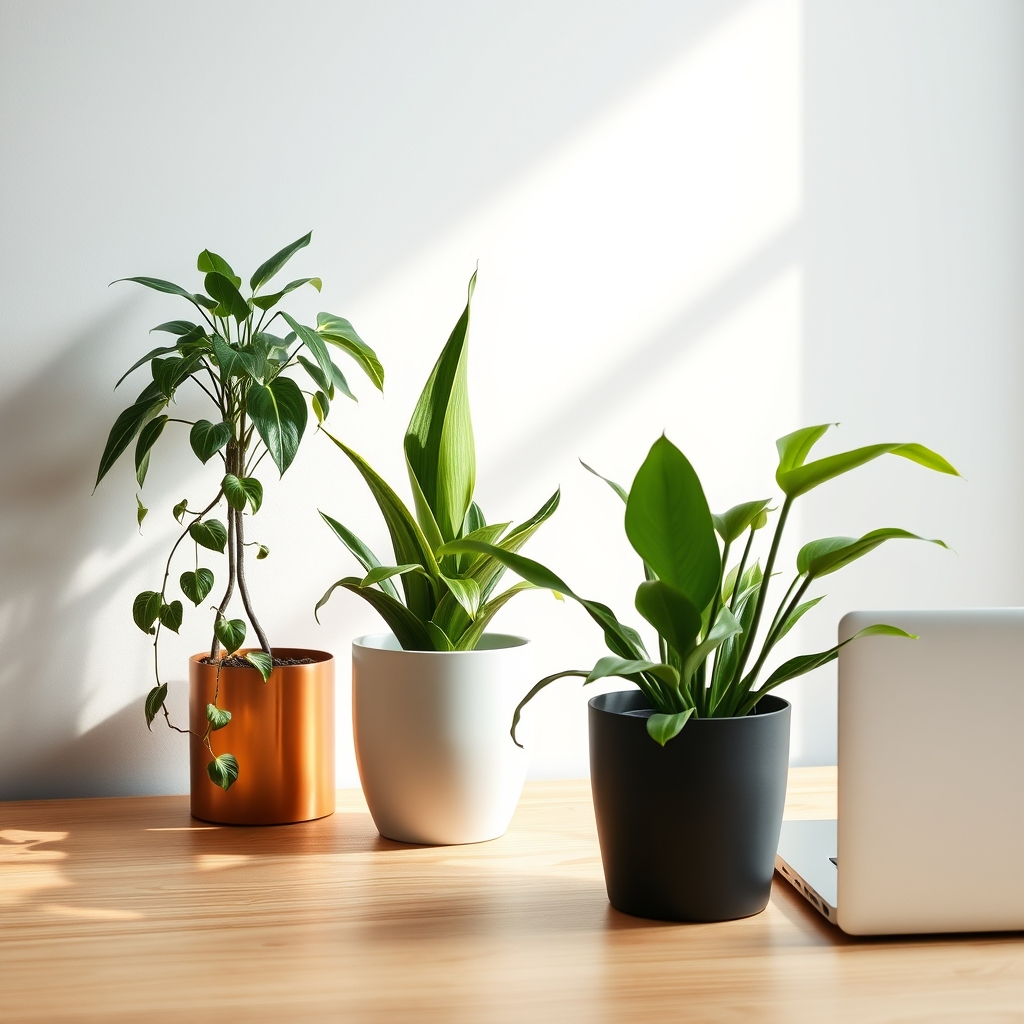
Plants that thrive with minimal attention and can withstand varying office conditions, making them ideal for professionals with limited time for plant care.
These plants typically feature sturdy foliage, drought tolerance, and adaptability to artificial lighting.
Popular easy-care office plants include:
- Snake Plant (Sansevieria): Upright, sword-like leaves
- ZZ Plant (Zamioculcas): Glossy, dark green stems
- Pothos: Trailing vines with heart-shaped leaves
- Chinese Evergreen (Aglaonema): Varied leaf patterns
- Spider Plant: Arching leaves with plantlets
Ideal Growing Conditions:
- Light: Tolerant of low to moderate light; avoid direct sunlight
- Water: Allow soil to dry between waterings
- Temperature: 65-80°F (18-27°C)
- Humidity: Adaptable to standard office humidity
- Soil: Well-draining potting mix
Maintenance Tips:
- Water monthly or when top 2 inches of soil feels dry
- Dust leaves monthly with damp cloth
- Rotate plants quarterly for even growth
- Remove dead or yellowing leaves promptly
- Repot every 2-3 years or when roots become crowded
- Skip fertilizer during winter months
- Monitor for common pests like spider mites and mealybugs
Colorful Flowering Plants to Brighten Your Workspace
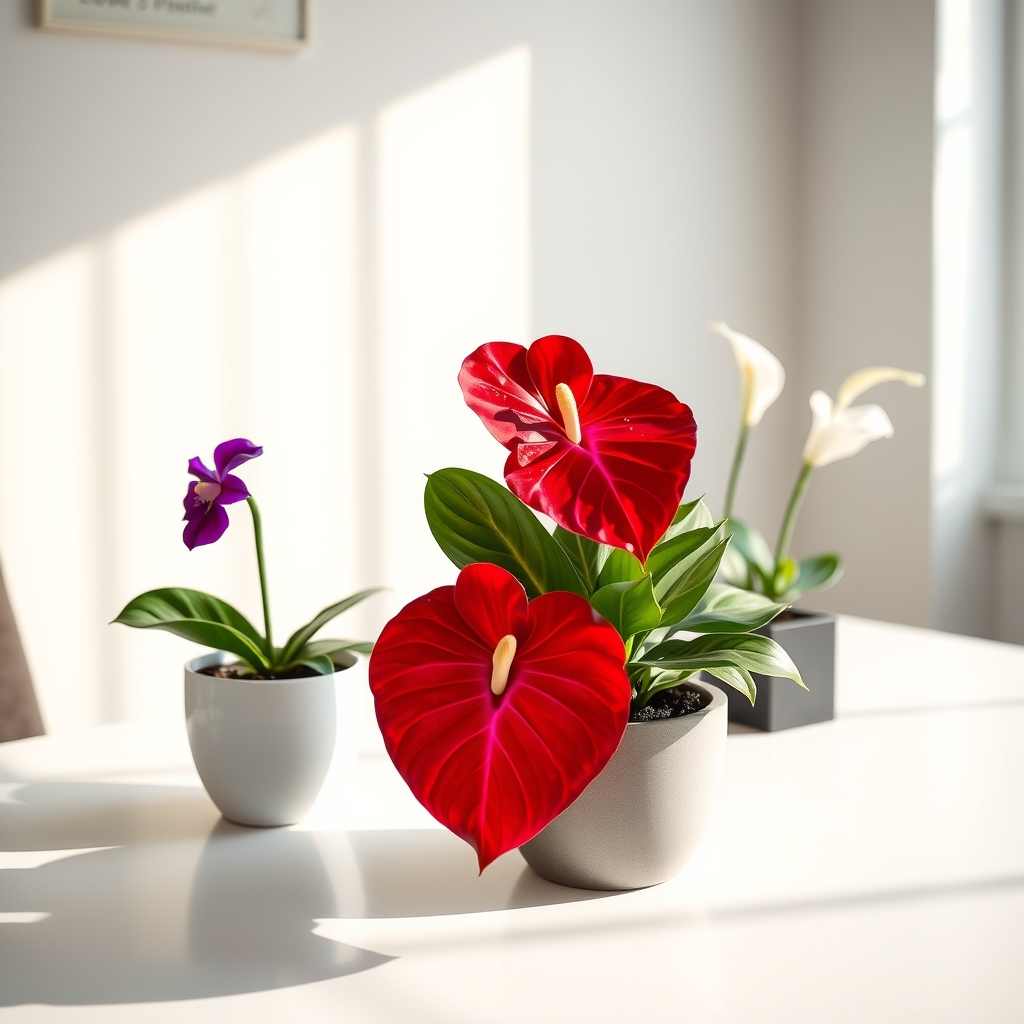
Description:
Flowering office plants add vibrant bursts of color and natural beauty to workspaces while purifying the air. Popular options include Peace Lilies with elegant white blooms, African Violets featuring purple, pink, or white flowers, and Anthuriums with glossy heart-shaped leaves and striking red blooms.
Orchids display exotic, long-lasting flowers in various colors, while Kalanchoes offer clusters of small, bright flowers in orange, yellow, or red.
Ideal Growing Conditions:
- Light: Most flowering plants prefer bright, indirect sunlight. Avoid direct sun exposure which can burn leaves and flowers
- Water: Maintain consistently moist but not waterlogged soil
- Temperature: 65-80°F (18-27°C)
- Humidity: Moderate to high humidity levels (40-60%)
- Soil: Well-draining potting mix specific to flowering plants
- Container: Pots with drainage holes to prevent root rot
Maintenance Tips:
- Remove spent blooms promptly to encourage new flower production
- Dust leaves regularly to maintain photosynthesis efficiency
- Fertilize monthly during growing season with balanced, water-soluble fertilizer
- Rotate plants quarterly to ensure even growth
- Monitor for common pests like spider mites and aphids
- Repot every 2-3 years or when roots become crowded
- Clean containers and saucers periodically to prevent bacterial growth
